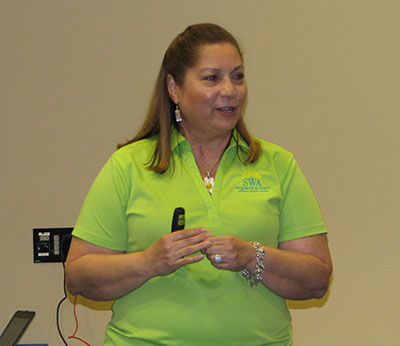By M. Dennis Taylor
Palm Beach, the largest county east of the Mississippi River, produces 16.8 million pounds of garbage every day — 12 pounds for each of the 1.4 million residents, a $187 million annual expense. Recycling cuts down that amount by about half.
For years, the number one recycled product was newspapers. Today, consumer habits have changed. As consumption of printed newspapers has fallen, the most recycled material is now cardboard, which is growing.
“It’s called the Amazon Effect,” said Aurora Ortiz, an education specialist with the Solid Waste Authority of Palm Beach County, when she spoke at the Wellington branch library on Wednesday, March 21.
The purpose of the presentation was to talk trash. Ortiz said that the amount of trash generated by the county would fill a football stadium 11 feet high every day. The SWA, an independent government agency created by the Florida Legislature in 1975, collects that trash, recycling what it can and burning 90 percent of the remainder to create electricity.
The other 10 percent is made up of items that can’t be burned, either because they are too big or are inflammable, like old campers and cement blocks. “The program has extended the life of the landfill by 20 years,” Ortiz said.
The SWA generates enough electricity in its two Renewal Energy Facilities — the first beginning operation in 1989, the second went online in 2015 — to power some 75,000 homes. It earns the SWA about $75 million per year, in addition to supplying much of the electricity for its own operations.
This money goes to offset the costs of trash removal and disposal. “Whether you throw it away, recycle it away or flush it away, we put your waste to work,” Ortiz said.
Trash is burned to generate steam that turns turbines that generates the electricity that is sold to FPL. The water to produce the steam begins as rainwater runoff and is reclaimed, cooled and reused.
Recycled materials are sorted and packaged for sale to manufacturers who use them as raw materials for new products.
Ortiz explained that the two-bin procedure used by the SWA, followed by optical sorters to separate plastics with lasers, produces the highest quality selling materials. In fact, many communities, such as nearby Lake Worth, that had adopted a single bin, unsorted method, are reverting back to two bins due to the increased value of the recycling yields.
“We have a state-of-the-art quality control system,” said Ortiz, who gives VIP tours to visitors from across the nation and around the world. “The facility emits no waste, the ash goes to the sanitary landfill and we recover metals that — let us say — accidentally made it into the trash instead of being recycled.”
Ortiz noted that participation in the recycling program is voluntary, which is not the case all over the country.
“We are not allowed to say the ‘D’ word anymore,” said Ortiz referring to the antiquated concept of a “dump.”
A sanitary landfill is carefully managed and lined so the fluids associated with it do not leech into the drinking water. A landfill is only allowed to get 160 feet high, then it gets turned over to the county and retired to make a park or a golf course.
Ortiz answered questions that she said would help with “that heated debate in the kitchen over recycling and which bin something goes into.”
“When in doubt, throw it out, for at least it gets burned for energy,” she said.
However, the directions are printed on the side of the bins. Bins, which incidentally, belong to you.
“So, paint your name and address on them to keep your neighbors from acquiring extra, and feel free to put wheels on it, if you’d like,” Ortiz said.
Some pearls of trivia to impress family and friends include the topic of “plastics.” Yes, the plastic your mail or an Amazon product comes in might have a recyclable logo, but that won’t work for the SWA because of the contracts they have for selling it.
“The rule of thumb for plastic [with us] is that if liquid or food came in it — even peanut butter — it’s recyclable with us… And if the cap is plastic, put it back on and throw it in the bin,” said Ortiz who warned not to throw loose caps in. “They just fall through the conveyor belt.”
She warned against plastic bags. “No bags, please. They get caught in the conveyor belt, stop the line and have to be cut out by hand with scissors,” she said.
If it has a metal lid, throw the lid out. The only metal that’s recyclable here is aluminum cans, not foil or trays, and there is no need to wash the bottles. Water is precious; just put them in the blue bin.
Household hazardous waste can be brought to area facilities to dispose of free of charge. This includes paint, propane tanks, used oil, florescent light bulbs and rechargeable batteries.
What about that proverbial pizza box? Ortiz had a ready answer. “If it’s a greasy pizza box, tear off the greasy part and throw the rest in the yellow bin,” she said.
For questions, or to request new bins, call the SWA at (866) NEW-BINS.








